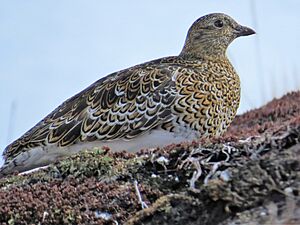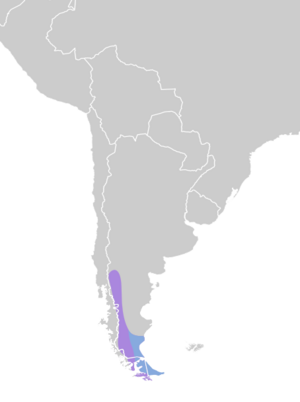White-bellied seedsnipe facts for kids
The white-bellied seedsnipe (Attagis malouinus) is a cool bird that lives in Argentina and Chile. It's a type of shorebird, which means it often hangs out near water or open land.
Quick facts for kids White-bellied seedsnipe |
|
|---|---|
 |
|
| Conservation status | |
| Scientific classification | |
| Genus: |
Attagis
|
| Species: |
malouinus
|
 |
|
| Range of A. malouinus
Nonbreeding Year-round |
|
Contents
What is a White-Bellied Seedsnipe?
The white-bellied seedsnipe is a medium-sized bird. It is about 26.5 to 29 centimeters (10 to 11 inches) long. It weighs around 310 to 400 grams (11 to 14 ounces).
How to Identify a White-Bellied Seedsnipe
Both male and female seedsnipes look very similar. Their upper parts and chest have a cool pattern. It looks like scallops with buff, cinnamon, and black colors. Their chin and belly are white.
Female birds have a slightly less clear line between their chest and belly. Young seedsnipes look a lot like adults. They are just a bit lighter in color. They also have a slightly stronger scallop pattern.
Where Does the White-Bellied Seedsnipe Live?
This bird lives in southern Chile and west-central Argentina. You can find it all the way down to Tierra del Fuego. It also lives on islands near Cape Horn. Sometimes, a few birds might even fly to the Falkland Islands.
What Kind of Places Do They Like?
During the time they raise their young, they live on windy hills. These areas have plants like crowberry heath and cushion plants. They also like to be near small streams and wetlands. When it's not breeding season, they mostly live in the Patagonian steppe.
How Do White-Bellied Seedsnipes Behave?
Seasonal Movements
White-bellied seedsnipes breed high up in the mountains. They can be found between 650 and 2,000 meters (2,100 and 6,600 feet) high. When winter comes, they move down to lower areas.
In winter, they often gather in groups. These groups can have up to 50 birds or even more.
What Do They Eat?
The white-bellied seedsnipe eats crowberry plants. They also eat other types of plants. Scientists are still learning more about their full diet.
Reproduction and Life Cycle
Not much is known about how these birds raise their young. They lay eggs in December and January. Their nest is a shallow dip in the ground. It is lined with grass, moss, and lichen. Usually, they lay four eggs at a time.
What Do They Sound Like?
When white-bellied seedsnipes fly, they make calls. These calls sound excited. They say "tu-whit tu-whit" or "too-ee too-ee..." over and over.
Is the White-Bellied Seedsnipe Safe?
The IUCN (International Union for Conservation of Nature) says the white-bellied seedsnipe is of "Least Concern." This means they are not worried about it becoming endangered soon. The bird lives in a very large area. Even though we don't know exactly how many there are, their numbers seem steady.
There are no big threats to them right now. Many parts of their home in Chile and Argentina are protected areas. They also live in tough, hard-to-reach places. This helps keep them safe from people.


